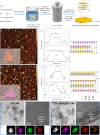Engineered Half-Unit-Cell MoS2/ZnIn2S4 Monolayer Photocatalysts and Adsorbed Hydroxyl Radicals-Assisted Activation of Cα-H Bond for Efficient Cβ-O Bond Cleavage in Lignin to Aromatic Monomers
- PMID: 39215384
- PMCID: PMC11403551
- DOI: 10.1021/acsami.4c10515
Engineered Half-Unit-Cell MoS2/ZnIn2S4 Monolayer Photocatalysts and Adsorbed Hydroxyl Radicals-Assisted Activation of Cα-H Bond for Efficient Cβ-O Bond Cleavage in Lignin to Aromatic Monomers
Abstract
Photocatalysis has high potential in the cleavage of Cβ-O bond in lignin into high-value aromatic monomers; however, the inefficient Cα-H bond activation in lignin and a low hydrogen transfer efficiency on the photocatalyst's surfaces have limited its application in photocatalytic lignin conversion. This study indicates that the cleavage of the Cβ-O bond can be improved by the generation of the Cα radical intermediate through Cα-H bond activation, and the formation of desirable aromatic products can be significantly improved by the enhanced hydrogen transfer efficiency from photocatalyst surfaces to aromatic monomeric radicals. We elaborately designed the half-unit-cell MoS2/ZnIn2S4 monolayer with a thickness of ∼1.7 nm to promote the hydrogen transfer efficiency on the photocatalyst surfaces. The ultrathin structure can shorten the diffusion distance of charge carriers from the interior to the surfaces and tight interface between MoS2 and ZnIn2S4 to facilitate the migration of photogenerated electrons from ZnIn2S4 to MoS2, therefore improving the selectivity of desirable products. The adsorbed hydroxyl radical (*OH) on the surfaces of MoS2/ZnIn2S4 from water oxidation can significantly reduce the bond dissociation energy (BDE) of Cα-H bond in PP-ol from 2.38 to 1.87 eV, therefore improving the Cα-H bond activation. The isotopic experiments of H2O/D2O indicate that the efficiency of *OH generation is an important step in Cα-H bond activation for PP-ol conversion to aromatic monomers. In summary, PP-ol can completely convert to 86.6% phenol and 82.3% acetophenone after 1 h of visible light irradiation by using 3% MoS2/ZnIn2S4 and the assistance of *OH, which shows the highest conversion rate compared to previous works.
Keywords: Cβ−O bond cleavage; activation of Cα−H bond; half-unit-cell MoS2/ZnIn2S4 monolayer; hydrogen transfer efficiency; lignin valorization.
Conflict of interest statement
The authors declare no competing financial interest.
Figures










Similar articles
-
Improved Lignin Conversion to High-Value Aromatic Monomers through Phase Junction CdS with Coexposed Hexagonal (100) and Cubic (220) Facets.ACS Appl Mater Interfaces. 2024 Jun 12;16(23):29991-30009. doi: 10.1021/acsami.4c02315. Epub 2024 Jun 3. ACS Appl Mater Interfaces. 2024. PMID: 38831531 Free PMC article.
-
Z-scheme H5PMo10V2O40/g-C3N4 heterojunction with strong photooxidative capacity for promoting efficient cleavage of Cα-Cβ bond in lignin models and lignin.Int J Biol Macromol. 2025 Feb;288:138709. doi: 10.1016/j.ijbiomac.2024.138709. Epub 2024 Dec 11. Int J Biol Macromol. 2025. PMID: 39672400
-
Enhancing oxidation ability of graphitic carbon nitride photocatalysts to promote lignin Cα-Cβ bond cleavage in micellar aqueous media.Int J Biol Macromol. 2023 May 1;236:124029. doi: 10.1016/j.ijbiomac.2023.124029. Epub 2023 Mar 14. Int J Biol Macromol. 2023. PMID: 36924872
-
Photocatalytic depolymerization of lignin via oxidizing cleavage of Cα-Cβ bonds in micellar aqueous media.Int J Biol Macromol. 2023 Aug 1;245:125476. doi: 10.1016/j.ijbiomac.2023.125476. Epub 2023 Jun 22. Int J Biol Macromol. 2023. PMID: 37353112
-
Near-Infrared Light Driven ZnIn2S4-Based Photocatalysts for Environmental and Energy Applications: Progress and Perspectives.Molecules. 2023 Feb 24;28(5):2142. doi: 10.3390/molecules28052142. Molecules. 2023. PMID: 36903386 Free PMC article. Review.
References
-
- Luo N.; Wang M.; Li H.; Zhang J.; Liu H.; Wang F. Photocatalytic Oxidation-Hydrogenolysis of Lignin β-O-4 Models via a Dual Light Wavelength Switching Strategy. ACS Catal. 2016, 6 (11), 7716–7721. 10.1021/acscatal.6b02212. - DOI
-
- Luo N.; Wang M.; Li H.; Zhang J.; Hou T.; Chen H.; Zhang X.; Lu J.; Wang F. Visible-Light-Driven Self-Hydrogen Transfer Hydrogenolysis of Lignin Models and Extracts into Phenolic Products. ACS Catal. 2017, 7 (7), 4571–4580. 10.1021/acscatal.7b01043. - DOI
-
- Wu X.; Fan X.; Xie S.; Lin J.; Cheng J.; Zhang Q.; Chen L.; Wang Y. Solar Energy-Driven Lignin-First Approach to Full Utilization of Lignocellulosic Biomass under Mild Conditions. Nat. Catal. 2018, 1 (10), 772–780. 10.1038/s41929-018-0148-8. - DOI
-
- Auma Omondi E.; Aluda Kegode A. Chemical Pretreatment in Lignocellulosic Biomass, Anaerobic Digestion, and Biomethanation. Clean Energy Sci. Technol. 2023, 1 (2), 1–19. 10.18686/cest.v1i2.70. - DOI
LinkOut - more resources
Full Text Sources
Miscellaneous

